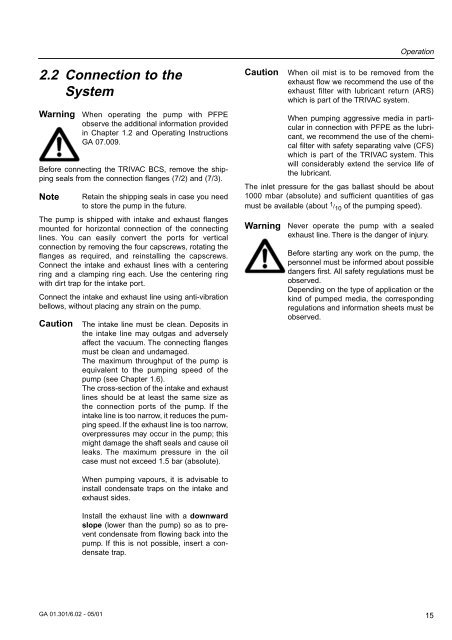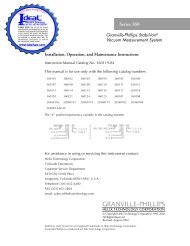Leybold D65BCS, D40BCS, Instruction Manual - Ideal Vacuum ...
Leybold D65BCS, D40BCS, Instruction Manual - Ideal Vacuum ...
Leybold D65BCS, D40BCS, Instruction Manual - Ideal Vacuum ...
You also want an ePaper? Increase the reach of your titles
YUMPU automatically turns print PDFs into web optimized ePapers that Google loves.
Operation<br />
2.2 Connection to the<br />
System<br />
Warning<br />
When operating the pump with PFPE<br />
observe the additional information provided<br />
in Chapter 1.2 and Operating <strong>Instruction</strong>s<br />
GA 07.009.<br />
Before connecting the TRIVAC BCS, remove the shipping<br />
seals from the connection flanges (7/2) and (7/3).<br />
Note<br />
Retain the shipping seals in case you need<br />
to store the pump in the future.<br />
The pump is shipped with intake and exhaust flanges<br />
mounted for horizontal connection of the connecting<br />
lines. You can easily convert the ports for vertical<br />
connection by removing the four capscrews, rotating the<br />
flanges as required, and reinstalling the capscrews.<br />
Connect the intake and exhaust lines with a centering<br />
ring and a clamping ring each. Use the centering ring<br />
with dirt trap for the intake port.<br />
Connect the intake and exhaust line using anti-vibration<br />
bellows, without placing any strain on the pump.<br />
Caution<br />
The intake line must be clean. Deposits in<br />
the intake line may outgas and adversely<br />
affect the vacuum. The connecting flanges<br />
must be clean and undamaged.<br />
The maximum throughput of the pump is<br />
equivalent to the pumping speed of the<br />
pump (see Chapter 1.6).<br />
The cross-section of the intake and exhaust<br />
lines should be at least the same size as<br />
the connection ports of the pump. If the<br />
intake line is too narrow, it reduces the pumping<br />
speed. If the exhaust line is too narrow,<br />
overpressures may occur in the pump; this<br />
might damage the shaft seals and cause oil<br />
leaks. The maximum pressure in the oil<br />
case must not exceed 1.5 bar (absolute).<br />
Caution<br />
When oil mist is to be removed from the<br />
exhaust flow we recommend the use of the<br />
exhaust filter with lubricant return (ARS)<br />
which is part of the TRIVAC system.<br />
When pumping aggressive media in particular<br />
in connection with PFPE as the lubricant,<br />
we recommend the use of the chemical<br />
filter with safety separating valve (CFS)<br />
which is part of the TRIVAC system. This<br />
will considerably extend the service life of<br />
the lubricant.<br />
The inlet pressure for the gas ballast should be about<br />
1000 mbar (absolute) and sufficient quantities of gas<br />
must be available (about 1 / 10 of the pumping speed).<br />
Warning<br />
Never operate the pump with a sealed<br />
exhaust line. There is the danger of injury.<br />
Before starting any work on the pump, the<br />
personnel must be informed about possible<br />
dangers first. All safety regulations must be<br />
observed.<br />
Depending on the type of application or the<br />
kind of pumped media, the corresponding<br />
regulations and information sheets must be<br />
observed.<br />
When pumping vapours, it is advisable to<br />
install condensate traps on the intake and<br />
exhaust sides.<br />
Install the exhaust line with a downward<br />
slope (lower than the pump) so as to prevent<br />
condensate from flowing back into the<br />
pump. If this is not possible, insert a condensate<br />
trap.<br />
GA 01.301/6.02 - 05/01<br />
15

















